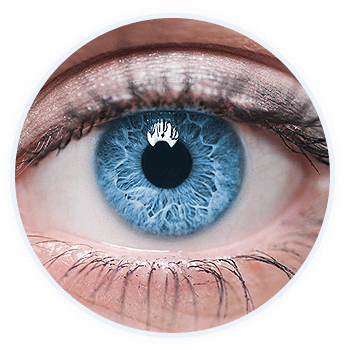What is Dry Eye?
Dry Eye is a very common condition that can affect everyone at some point during his or her life. Mild cases can be managed with natural tears while more severe cases may require additional treatment. Dry Eye is a reduction in your eyes’ natural ability to produce sufficient natural tears. Tears serve to lubricate the eye and are produced around the clock. When insufficient moisture is produced, stinging, burning, scratchiness and other symptoms are experienced and may be referred to as Dry Eye. With the increased use of computers, smartphones, and video games, the dry eyes condition has become so prevalent it is now being classified as a disease and poses a significant quality of life issue.
How does Dry Eye Disease happen?
There are 3 types of tears: reflex, emotional and basal. Basal tears are a very important to vision and eye health and surprisingly more complex than most people realize. When we blink, tears form a film that spreads over the eye, making the surface smooth, optically clear and enabling good vision. Tears also protect the cornea, one of the most sensitive tissues of the body which is densely packed with sensory nerves. There are three layers in the thin film of basal tears:
- An oily layer – Small glands at the edge of the eyelid called meibomian glands produce the outermost oily layer. Its main purpose is to smooth the tear surface and reduce evaporation.
- The middle watery layer is produced by small glands scattered through the conjunctiva, the delicate membrane lining the inside of the eyelid, and by the large lacrimal or tear glands. This layer cleanses the eye and washes away foreign particles or irritants.
- A mucus layer acts like a magnet to spread the water layer evenly over your eye’s surface. Without mucus, tears would not adhere to the eye
When these layers fail to work together, the tear system becomes imbalanced and dry spots develop.
Why is Dry Eye Disease a problem
The damage caused by Dry Eye Disease is irreversible. And with people of all ages on screens, all day, diagnoses are on the upswing. Freedom from redness, burning and stinging is about early detection and treating the cause, not just the symptoms. At VisionPoint Eye Center Dry Eye Clinic, we use advanced diagnostic tests to detect Dry Eye Disease at its earliest signs, then monitor eyes for inflammation and abnormal, unhealthy tears. From simple effective treatments such as heat, massage, and prescription drops to our innovative, drug-free Intense Pulsed Light treatment, patients experience life-changing relief and prevention.
FAQ’s
Do artificial tears work for Dry Eye Disease?
Mild dry eyes can be relieved by using artificial tears. However, if you find yourself using drops more than 4 times a day, your dry eye symptoms should be tested. By the time eyes start feeling dry on a regular basis, irreparable damage may have already occurred. Eyedrops are meant only as a temporary fix — not a long-term solution. In fact, overusing eyedrops can actually put your eye health at risk. Many over-the-counter eyedrops contain preservatives and using these drops more often can cause eye irritation. Non-preservative eyedrops come in packages that contain multiple single-use vials. After you use a vial, you throw it away.
Can blinking more help dry eyes?
The basal blink rate is an involuntary function. When you are working on the computer or playing a video game, your brain is engaged in a higher brain function that overrides the blink reflex. Simply put, our natural blink rate slows down considerably when we are watching screens and it is impossible to continually think about blinking. That is why dry eye disease is increasing among people who spend lots of time on screens.
What are the complications of dry eyes?
Chronic or untreated dry eye can create greater risk for eye infections and a decreased ability to perform tasks such as reading, driving, and working with computers. In severe untreated cases, dry eye can result in eye inflammation, corneal abrasions and ulcers, and permanent vision problems.
Are there natural ways to manage eye dryness?
The following approaches can help manage dry eyes
- Use over-the-counter lubricant eye drops, gels, or ointments, as recommended by your eye doctor
- Use a humidifier
- Apply the 20/20/20 rule when working on computer screen for long periods; look 20 feet (or more) away every 20 minutes for 20 seconds.
- Wear glasses instead of contacts
- Wear sunglasses when outdoors
- Drink plenty of water
- Avoid smoke
- Apply a warm damp washcloth to soothe irritated eyes
- Avoid harsh cleaners around the eye area
- Take nutritional supplements containing essential fatty acids (consult your doctor)
What Causes Dry Eye?
Dry Eye is often caused by environmental factors such as:
- Indoor heating, air conditioning, overhead fans
- Computer use
- Digital devices
- Exposure to smoking
- Seasonal humidity
- Dry climates
- Windy conditions
Dry eye can also be caused by medical factors such as:
- Medications for blood pressure, depression, anxiety, asthma, allergies, glaucoma, birth control and more
- Many autoimmune and inflammatory diseases can affect dry eyes such as rosacea, diabetes, rheumatoid arthritis, thyroid disease, lupus, Sjögren’s syndrome
This can happen as part of the normal aging process but may not always be noticed because the effect of Dry Eye tends to balance another age-related change; poor tear drainage. Dry Eye is also more common among women. Almost 69% of perimenopausal and menopausal women are affected by Dry Eye Disease.
Symptoms
- Dramatic fluctuation in vision
- Burning
- Persistent redness
- Foreign body sensation in the eye
- Eyes feel scratchy, gritty, irritated
- Light sensitivity
- Watery eyes – body produces reflex tears to offset the eye dryness, but these tears don’t have the quality of basal tears
The following are some precautions you can take to prevent or minimize Dry Eye:
- Avoid drafts from heating or air conditioning vents, especially in cars or airplanes.
- Take frequent breaks to relieve eye strain during periods of prolonged computer use.
- Remove your contact lenses and keep them especially clean when your eyes are feeling dry.
- After LASIK surgery, use artificial tears to soothe and comfort your eyes during recovery.
- Be aware that certain over the counter medications and prescription drugs can contribute to Dry Eye.
- Know that natural changes in tear production and composition often occur due to age or disease.
How is Dry Eye Disease Diagnosed?
SPEED Questionnaire
SPEED is an acronym for Standard Patient Evaluation of Eye Dryness. This simple 12 question tool is designed to track the progression of dry eye symptoms over time. This is often where testing starts to get a measure of the type, frequency and severity of symptoms.
Tear Lab
- Tear Lab Measures tear osmolarity
Inflammadry
- InflammaDry is the first and only rapid, in-office CLIA-waived test that detects elevated levels of MMP-9, an inflammatory marker that is consistently elevated in the tears of patients with dry-eye disease. Other dry-eye tests only measure tear production and stability. InflammaDry accurately identifies patients with inflammation so patients can start treatments that address the cause of their dry eye disease.
Keratograph
- A keratograph takes a picture of the eye surface and shows the tear film quality and gland structure of the Meibomian glands responsible for producing the oil layer of basal tears. Dysfunction of the Meibomian gland is the most common cause of dry eye disease.
Blepharitis
Blepharitis is chronic condition that causes inflammation of the oil glands in the eyelids and is a common cause of dry eyes. It often recurs and needs repeated treatment. Blepharitis is caused by inflammation of the eyelid margin, the edge of the eye from which your eyelashes grow. Debris and protein build-up at the base of eyelashes are called “collarettes” in blepharitis.
There are many factors that contribute to blepharitis. The most common factors are poor eyelid hygiene, blocked glands in the eyelids, excess oil produced by the glands in the eyelid, a bacterial infection (often staphylococcal) or an allergic reaction.
Careful, daily cleaning of the eyelashes can usually control blepharitis. This can be accomplished by moistening a clean washcloth with tap water as warm as you can stand without burning. Hold the washcloth against the eyelids until it cools, then re-warm and repeat for five to ten minutes. We recommend using a clock to follow the time. After soaking, each eyelid should be gently scrubbed for one minute.
If cleaning your eyelids at home isn’t alleviating your symptoms, your doctor may recommend BlephEx: a new, in-office procedure that allows your doctor to take an active role in cleaning your eyelid margins. This treatment cleans your eyelids and removes excess bacterial, biofilm, and bacterial toxins, the main causes of eyelid symptoms. With regular treatments, the eyelids stay clean and symptom-free. BlephEx is the first and only doctor eyelid cleaning procedure to help maintain clean and healthy lids.
The doctors at VisionPoint Eye Center can prescribe antibiotics if necessary. Blepharitis, if left untreated, can lead to severe infections. Always consult an eye care practitioner before beginning any treatment on your eyes.










